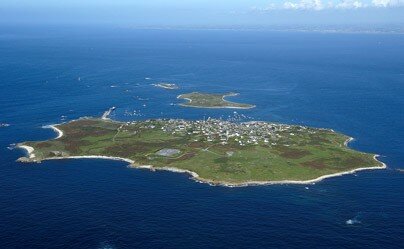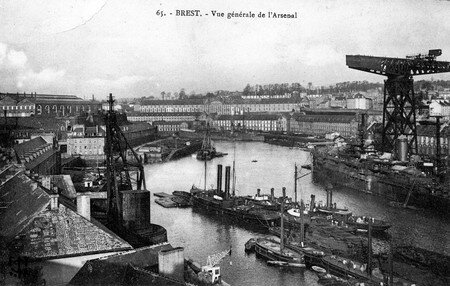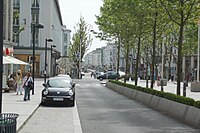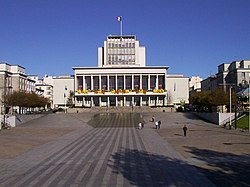MOLENE- BREST
PLAY MUSIC ![]()
Molène
Together with several neighbouring islets, it forms the commune of Île-Molène. The island is small, less than 1 by 0.9 km, and has an area of 75 hectares. Its population has declined in recent decades, but Molène remains inhabited, with a population of 277 (2005 census). The community and only port are located to the east of the island, opposite a small island called the Lédénes of Molène that becomes connected at low tide.
The island's electricity is produced by a small diesel generator. Potable water supplies are from rainwater catchment, with each household additionally maintaining its own cistern.
A local delicacy is Molène sausage, which has the distinction of being smoked with seaweed.
Brest
(click on the pictures to enlarge) 
| Location | ||
| Coordinates | 48°23′27″N, 4°29′8″W | |
| Administration | ||
|---|---|---|
| Country | France | |
| Region | Bretagne | |
| Department | Finistère (sous-préfecture) | |
| Arrondissement | Brest | |
| Canton | Chief town of 10 cantons | |
| Intercommunality | Brest Métropole Océane | |
| Mayor | François Cuillandre (2001–2008) | |
| Statistics | ||
| Altitude | 0 m–103 m (avg. 34 m) | |
| Land area¹ | 49.51 km² | |
| Population² (1999) |
149,634 | |
| - Density | 3,022.3/km² (1999) | |
| Miscellaneous | ||
| INSEE/Postal code | 29019/ 29200 | |
| 1 French Land Register data, which excludes lakes, ponds, glaciers > 1 km² (0.386 sq mi or 247 acres) and river estuaries. | ||
| 2 Population sans doubles comptes: single count of residents of multiple communes (e.g. students and military personnel). | ||
Brest is a city in Brittany, or the Bretagne région, north-west France, sous-préfecture of the Finistère département. Located on the western tip of Brittany, the city is an important port and naval base. The population of the city was estimated at 146,000 as of 2004; the population of the metropolitan area was recorded as 303,484 inhabitants in the 1999 census. Although the city is by far the largest in Finistère, its préfecture (capital) resides in the much smaller commune of Quimper.
History
Brest in 1779
Nothing definite is known of Brest until about 1240, when it was ceded by a count of Léon to John I., duke of Brittany. In 1342 John of Montfort gave it up to the English, and it did not finally leave their hands till 1397. Its medieval importance was great enough to give rise to the saying, "He is not duke of Brittany who is not lord of Brest." By the marriage of Francis I. with Claude, daughter of Anne of Brittany, Brest with the rest of the duchy definitely passed to the French crown. The advantages of the situation for a seaport town were first recognized by Richelieu, who in 1631 constructed a harbour with wooden wharves, which soon became a station of the French navy. Colbert changed the wooden wharves for masonry and otherwise improved the post, and fortifications by Vauban (1633–1707) followed in 1680-1688. During the 18th century the fortifications and the naval importance of the town continued to develop.
followed in 1680-1688. During the 18th century the fortifications and the naval importance of the town continued to develop.
In 1694 an English squadron under John Berkeley, 3rd Baron Berkeley of Stratton, was miserably defeated in the Attack on Brest; but in 1794, during the revolutionary war, the French fleet, under Villaret de Joyeuse, was as thoroughly beaten in the same place by the English admiral Howe.
During World War II, the Germans held a large submarine base in Brest. Destroyed at the Battle for Brest, the city has since been rebuilt. (There were about three buildings left standing.) After the end of the war, the West German government had to pay several billion dollars of reparations as compensation to the homeless and destitute civilians in the city for any of their homes or property which were damaged or destroyed in the war. The rebuilt city consists primarily of utilitarian gray granite and concrete buildings.
In 1972, the base of the French submarine nuclear deterrence was opened at Île Longue, in the roadstead of Brest.
Coat of arms
It is in a register of deliberations of the city council dated the 15th July 1683 that this coat of arms was used for the first time.
Geography
Brest is located amidst dramatic landscape near the entrance of the natural Rade de Brest, at the west end of Brittany.
It is situated to the north of a magnificent landlocked bay, and occupies the slopes of two hills divided by the river Penfeld,—the part of the town on the left bank being regarded as Brest proper, while the part on the right is known as Recouvrance. There are also extensive suburbs to the east of the town. The hill-sides are in some places so steep that the ascent from the lower to the upper town has to be effected by flights of steps and the second or third storey of one house is often on a level with the ground storey of the next.
Economy
Due to its location, Brest is regarded as the first French port that can be accessed from the Americas, and hence shipping is big business, although Nantes and Saint-Nazaire offer much larger docks and attract more of the larger vessels. Its protected location means that it is ideal to receive any type of ship, from the smallest dinghy to the biggest airplane carrier (the USS Nimitz has visited a few times).
The Charles De Gaulle aircraft carrier was built by DCN in Brest.
Monuments and tourist attractions
Brest is known thanks to the Recouvrance Bridge (a massive drawbridge 64 m/210ft high), the military arsenal and the rue de Siam (Siam Street). The Castle and the Tour Tanguy are the oldest monuments of Brest.
The Musée de la Tour Tanguy houses a collection of dioramas that depict the city of Brest on the eve of World War II. The Musée de la Marine de Brest contains exhibits which outline Brest's maritime tradition. There is also an aquarium, the Océanopolis marine centre.
The city of Brest hasn't much historical architecture, apart from a few select monuments such as the Castle and the Tour Tanguy. This is due to heavy allied bombing during World War II, in an attempt to destroy the submarine base the Germans had built in the harbour. The town was hastily rebuilt in the 1950s using a large amount of concrete. In Recouvrance, the left bank of the town, it remains an authentic street of the 17th century, Saint-Malo Street.
A few kilometres out of town, there are more impressive landscapes, from sandy beaches to grottos to tall granite cliffs. Sunbathing, windsurfing, yachting and fishing are practiced in the area. Brest was an important warship producing port in the Napoleonic wars. The naval port, which is in great part excavated in the rock, extends along both banks of the Penfeld;
Panorama of the castle and the Tour Tanguy
Administration
The city hall, place de la Liberté
- since 2001: François Cuillandre
- 1989 - 2001: Pierre Maille (2nd term)
- 1985 - 1989: Georges Kerbrat
- 1983 - 1985: Jacques Berthelot
- 1982 - 1983: Pierre Maille
- 1977 - 1982: Francis Le Blé
- 1973 - 1977: Eugène Berest
- 1959 - 1973: Georges Lombard
- 1958 - 1959: Auguste Kervern
- 1954 - 1958: Yves Jaouen
- 1954 - 1954: Lucien Chaix
- 1953 - 1954: Yves Jaouen
- 1947 - 1953: Alfred Pierre Marie Chupin
- 1945 - 1947: Jules Lullien
- 1944 - 1945: Jules Lullien
- 1942 - 1944: Victor Eusen
- 1929 - 1941: Victor Le Gorgeu
- 1921 - 1929: Léon Nardon
- 1920 - 1921: Hippolyte Masson
- 1919 - 1920: Louis Léon Nardon
- 1912 - 1919: Hippolyte Masson
- 1908 - 1912: Louis Arthur Delobeau
- 1904 - 1908: Victor Marie Aubert
- 1900 - 1904: Charles Berger
Culture-Regional language
Breton is not commonly spoken in the city of Brest and is not an official language (in the same vein as other French minority languages). It is being taught in some schools and universities. The association Skedfederates all Breton cultural activities.
Brest was the only "French-speaking" city in western Brittany before the 1789 revolution.
The city is host to several events to celebrate its long maritime history, the largest of which happens every four years, when the town organises a tall ship meeting. The last occurrence of that event was "Brest 2004".
Brest also hosts a yearly Short Film Festival called "Festival Européen du Film Court de Brest"
The city was also the setting for the 1982 art film Querelle.
Food in Brest
Restaurants in Brest have a wide variety of seafood. Fresh fish is featured on practically every menu and you can even find a few fish-only restaurants. Local markets and supermarkets also offer lots of seafood.
Brittany's most famous local delicacy, the Breton crêpe, is another culinary feature. There are many crêpe restaurants (called crêperies) and Breton cider may also be drunk.
Traditional biscuits include Traou Mad which is a full fat butter biscuit, somewhat similar to Scottish shortbreads.
Sport
Since 1901 Brest has served as the midpoint for the epic 1200 km bicycle endurance event, Paris-Brest-Paris. Brest is home to Stade Brestois 29, a football team in Ligue 2, the second-highest league in French football.
Education
- Brest has a university: Université de Bretagne Occidentale (UBO) [2]
- Brest has several grandes écoles:
- École nationale d'ingénieurs de Brest (ENIB) [3]
- École nationale supérieure des télécommunications de Bretagne (ENST Bretagne) [4]
- École nationale supérieure des ingénieurs des études et techniques d'armement (ENSIETA) [5]
- Institut supérieur de l'électronique et du numérique de Brest (ISEN Brest) [6]
- École supérieure de commerce de Bretagne [7]
- École Navale [8]
- Brest also is one of the hosts for the IU Honors Foreign Language Program
Births
Brest was the birthplace of:
- Charles-Alexandre Léon Durand Linois (1761–1848), admiral during the time of Napoleon Bonaparte
- Prosper Garnot (1794–1838), surgeon and naturalist
- Victor Segalen (1878–1919), naval doctor, ethnographer, archeologist, writer and poet
- Georges Thierry d'Argenlieu (1889–1964), priest, diplomat and French Navy officer and admiral
- Alain Robbe-Grillet (born 1922), writer and filmmaker
- Pierre Brice (born 1929), actor
- Béatrice Dalle (born 1964), actress
- Yann Tiersen (born 1970), minimalist multi instrumentalist
- Gonzalo Higuaín (born 1987), Real Madrid and Argentina footballer
- Christophe Miossec (born 1964), singer


















![Resident Evil : Degeneration - Trailer [VO]](https://image.canalblog.com/MWwOngJgJdjMrgFUJgJeqqbl1wE=/400x260/smart/filters:no_upscale()/https%3A%2F%2Fassets.over-blog.com%2Ft%2Fcedistic%2Fcamera.png)
/https%3A%2F%2Fstorage.canalblog.com%2F37%2F82%2F381415%2F20815251_o.jpg)
/https%3A%2F%2Fstorage.canalblog.com%2F57%2F88%2F381415%2F21720693_o.jpg)
/https%3A%2F%2Fstorage.canalblog.com%2F65%2F35%2F381415%2F19562151_o.jpg)
/https%3A%2F%2Fstorage.canalblog.com%2F08%2F08%2F381415%2F19042209_o.jpg)
/https%3A%2F%2Fstorage.canalblog.com%2F86%2F94%2F381415%2F19038541_o.jpg)
/https%3A%2F%2Fstorage.canalblog.com%2F09%2F70%2F381415%2F19038067_o.jpg)
/https%3A%2F%2Fprofilepics.canalblog.com%2Fprofilepics%2F3%2F2%2F328227.jpg)